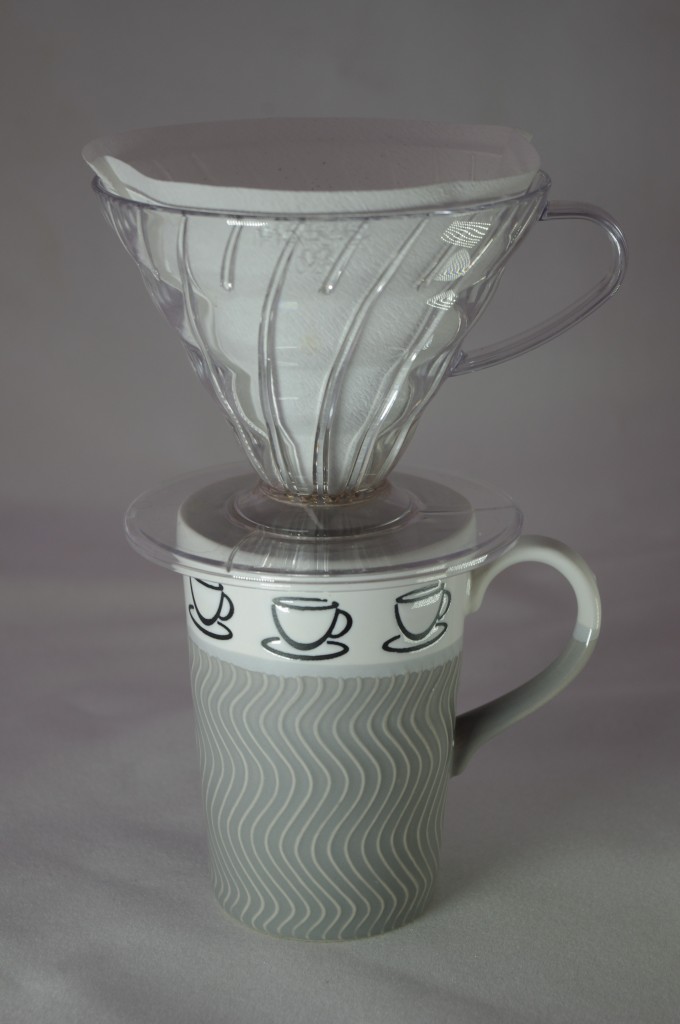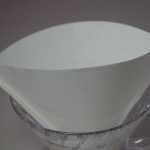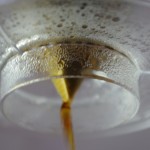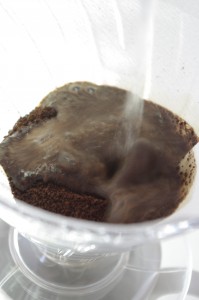There is hip and there is hip. The Hario V60 is definitely what the doctor ordered for the new slow coffee movement, that is brewed coffee done by hand, one cup at a time. I heard some marketing guru state the other day that the single-cup coffee market was going to be big. Really? That would have been big news a few years ago. Frankly, I’ve been using one-cup brewers for a dozen years, but I’m not claiming to be psychic.
They are just what the doctor ordered for upscale expensive beans, and my desire to drink a brewed cup par excellence. Manual drip brewing is a superb extraction method. Realize that brewing 10 cups at a time is difficult for drip because it takes so long for hot water to get hot, and get through the grounds without over-extracting and becoming bitter. One cup? No problem.Let’s look at what’s different about the Hario and why it’s getting such a buzz.
Brewer – the power of this brewer is the bottom, where the coffee exits. Usually it’s a tiny hole. This allows the brewer to regulate the water to help control how long the water is in contact with the grounds. If the water goes through too fast, you just get hot water. If it’s too slow, you get bitter coffee. The Hario hole is so big, it hardly controls the flow at all. This allows you to grind super fine and that is mostly a good thing. The Hario presumes you will grind your own coffee. If you use preground drip grind, it the water will likely run through too fast. The key to grinding is to grind fine enough to slow the drip, ending up with between four and six minutes contact between the water and grounds. In this way, it is similar to the Chemex, which also has a large gap at the filter bottom.
The filter is an extension of the philosophy of the exit hole. The filter appears designed to encourage flow, not hold it back. Again, this will encourage you to grind fine. The filter paper is designed to be practically transparent, quite different from Chemex’s, which seems thicker and slower in comparison.
Grind – so what grind you should use? I said between 4 and 6 minutes is the ideal contact time. But, why such a large spread? Well, this allows for your personal taste, but also when you grind finer for drip, there’s a double effect. The finer grind slows the flow, but it also increases contact area between the water and grounds, so trial and error is necessary. I found when brewing four cups, which this brewer is capable of, I ground slightly coarser, still a fine grind, but just a bit less fine, so that my entire batch was ready in six minutes. When I only needed to brew one cup, I ground superfine, but it still took less time because there was less water to run through the grounds, so I had to grind very fine, almost a powder, and due to the increased ground surface exposed to hot water, I got the same strength in about four minutes. Is that clear? I hope so.
The Hario has these swirling fins inside. One colleague of mine was just overwhelmed with this brilliance of this innovation. I must just be different, but I fail to see how important these are. They add a nice visual design touch, but I seriously doubt if they really encourage a specific flow in any significant way.
The Hario V60 is available in plastic, glass and ceramic versions. I tested the least expensive plastic version. I would expect the ceramic version to be allow the water to cool fastest, and glass perhaps slowest, but I’d reckon the water travels through the grounds so quickly that it won’t be an issue.
Here’s my method: Boil some good tasting water. Place one 10gram scoop of coffee per 6 ounce cup. I used Counter Culture’s Peruvian Valle de Santuario for my tests. Grind fine, finer than for auto drip, but definitely not espresso grind. As grind is so important to this brewer’s performance, expect to do some futzing to get the taste you like. Also expect to alter your grind if you change the batch brew volume. For four cups, I weighed 40 grams coffee, and backed off to almost an auto-drip grind. Then the contact time between grounds and water was just shy of 6 minutes. This particular coffee has vanilla, fig and chocolate notes in it and the Hario brought out all the noble acidity and richness I could ask for. I suspect the filter paper webbing has a lot to do with the extraordinary success of the Hario V60. The filter is the closest to a glass or fine mesh filter with all the flavor and oil you could ask for, yet absolutely no sediment.
The Hario V60 is a fine brewer, far from being overpriced and it is not just geek gear. If you want jewelry or high end kitchenware, you can buy a glass or ceramic model. It does not displace either the Melitta cone nor Chemex, but it offers a fun and good tasting option to manual brewing, and places a healthy emphasis on grinding fine, rather than counting on the exit hole or filter to regulate contact time. With its innovative filter paper that offers the best in flavor transparency, the Hario V60 is a winner.
Highly recommended.
©2010 Kevin Sinnott All rights reserved.







Thanks for this review. This would be a perfect solution for me as I don't tend to drink more than one cup of coffee in a day, and I am not a fan of having a regular coffee maker just to make one cup. Sounds like this makes a great cup of coffee!
Hey Kevin, you mentioned the Melitta at the end of your review…the Melitta is very similar in form, tho doesn’t have the open bottom. Have you compared the cups made by each? I’m an old (old!) time single cup Melitta user and i’m wondering if switching to a V60 would be an improvement. Thanks! Found you thru an old KCRW podcast!
The Melitta is designed to slow the coffee’s exit at the bottom. The Hario is designed to speed things up. Two different philosophies, but both make equally good coffee. I’d grind finer with the Hario, or overwhelm it with higher grounds to water ratios, which is what the roasters want you to do because it increases consumption. 😉 KCRW has the fine Evan Kleiman Good Food show and I’ve appeared on it a number of times in addition to being a regularly listener.
Hi Kevin,
You are my coffee guru and I started a passion listening to you after your sowden review video ..Your review was pretty cool, informative to customers , and was like reading a good piece of information loaded literature , with facts , comparisons and and its a breath of fresh air ! I am new to coffee …and am planning to buy some coffee gear ….Here are my questions if you can please answer ….and for now am enjoying coffee via Eva cafe solo …my current favourite one …
1. I am planning to buy hario v60 since you recommend ? ….Will the new paperless one be a good choice ? Will it deliver the same results the original one delivers which its big hole and spiral ridges ?
amzn.to/10PO54Q
2. Whats your choice ….plastic, glass, stainless steel or ceramic ….I love plastic and its convenient and cheap but scared of getting a dose of bpa along with my coffee …whats your thoughts ?
3. Whats your opinion on kalita wave ….the conical dripper with 3 holed flat bottom dripper from Japan ?
4. Whats your favorite coffee gear ?
Thanks a lot for your time !
Dan, I’m honored. Thank you. Now, to answer your questions.
1. I have not tried the filterless V60. The paper one works so well I’m in no hurry.
2. Most plastic now used is bpa-free. My favorite is glass. Ceramic is neutral but glass gets hot, a good thing because it holds brewing temperature. Stainless steel is good, but tends to take on brewing taste after awhile. Plastic is least neutral.
3. Kalita Wave is yet to be reviewed, but my initial tastings are positive.
4. My favorite? I’m unable to decide. Like asking Rembrandt his favorite color. 😉
I am looking forward to a Kalita Wave review, Coffee Kevin 😉 The Kalita may be the next pour-over brewer for my collection.
Yes, it’s on the list, Jason. I’ve heard good things, but there’s nothing like a prolonged test.